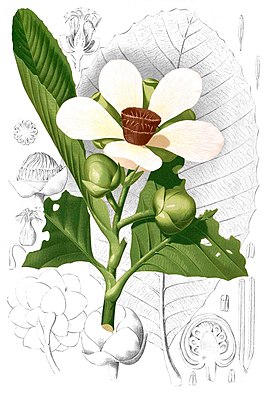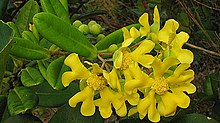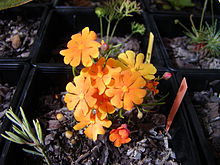Rose apple plants
| Rose apple plants | ||||||||||||
|---|---|---|---|---|---|---|---|---|---|---|---|---|

Dillenia reifferscheidia , illustration |
||||||||||||
| Systematics | ||||||||||||
|
||||||||||||
| Scientific name of the order | ||||||||||||
| Dilleniales | ||||||||||||
| DC. ex Bercht. & J. Presl | ||||||||||||
| Scientific name of the family | ||||||||||||
| Dilleniaceae | ||||||||||||
| Salisb. |
The rose apple family (Dilleniaceae) are a plant family within the flowering plants (Magnoliopsida). They occur from the tropics through the subtropics to the warm temperate zones.
description






The taxa of the family Dilleniaceae are very variable in most characteristics:
Appearance and leaves
There are great mostly deciduous woody plants: trees , shrubs or vines , rarely are they perennial herbaceous plants ( Acrotema ).
The leaves are usually fully developed, but in some species they are greatly reduced. In some species the leaves are only in a basal rosette, but in most species they are distributed on the branches, whereby they are usually alternate and spiral, rarely opposite ( Hibbertia coriacea ) on the branches. The stalked leaves are usually simple and often lobed. The leaf margins are smooth or serrated. The winged stipules are fused with the petioles or they are missing.
Inflorescences and flowers
The flowers stand alone or are grouped in terminal zymose or racemose inflorescences . The hermaphrodite flowers are radially symmetrical to zygomorphic and are usually five-fold. There are usually five (3 to 20, more than 14 in Tetracera ) free sepals . The (two to) usually five free, white or yellow petals can be divided into two parts. There are usually 15 to 150 (centrifugally propagated), rarely one to ten, free or fused stamens , they are either all fertile or partially sterile . Usually two to seven (one to 20) carpels are usually free or at a syncarp Upper permanent ovary grown. In each flower there are as many styles as carpels.
Fruits and seeds
The fruits are mostly follicles or nut fruits , less often capsule fruits or berries . The fruits are often still surrounded by the calyx. Follicles and nut fruits are usually grouped together in collective fruits. The fruits contain one to many seeds. The seeds often have an aril .
Systematics
The Dilleniaceae family was listed in 1806/7 by Richard Anthony Salisbury in The Paradisus Londinensis , sub, plate 73. Type genus is Dillenia L. Synonyms for Dilleniaceae Salisb. are: Delimaceae Martius , Hibbertiaceae J.Agardh , Soramiaceae Martynov .
According to APG III (2009), the Dilleniaceae did not have a stable position within the nuclear eudicotyledons . They were therefore not assigned to any order. According to APG IV (2016), the family is in its own order Dilleniales.
The family Dilleniaceae is divided into four subfamilies and contains about twelve genera with 300 to 410 species:
- Subfamily Doliocarpoideae JWHorn : with about five genera and about 65 species:
-
Curatella Loefl. : with the only kind:
- Curatella americana L .: This shrub or tree iswidespreadin the Neotropics .
- Davilla Vand. (Syn .: Tigarea Aubl. ): With about 25 species in the Neotropic.
- Doliocarpus Rol. : with about 45 species in the Neotropic. The center of biodiversity is Brazil.
-
Pinzona Mart. & Zucc. : with the only kind:
- Pinzona coriacea Mart. & Zucc. : It is widespread in the Neotropic. It's a liana.
-
Curatella Loefl. : with the only kind:
- Subfamily Dillenioideae Burnett : with about five genera and about 75 species:
- Acrotrema Jack : with 9 to 14 species, including about 7 in Sri Lanka , one in the Western Ghats in India, one with a wide distribution in Southeast Asia.
-
Didesmandra Stapf : with the only kind:
- Didesmandra aspera Stapf : Endemic to Sarawak .
- Dillenia L. (Syn .: Neowormia Hutch & Summerh.. , Wormia Rottb. , Reifferscheidia C.Presl ) with 58 to 65 species in the Mascarene Islands , in the southern and southeastern Asia , in Indonesia , Queensland (sort of) and Fiji . About 45 species are found in Malesia .
- Pachynema R.Br. ex DC. : Bushes mostly with severely reduced leaves, photosynthesis is done by the branches.
- Schumacheria Vahl : with around three species only in Sri Lanka .
- Subfamily Hibbertioideae JWHorn : with the only genus:
- Hibbertia Andrews (Syn .: Adrastaea DC. , Trimorphandra Brongn. & Gris , Trisema Hook. F. ): With about 225 species, only a few from Madagascar (one species) via New Guinea (two species), Australia (200 species), New Caledonia (24 species) to Fiji (one species). The main distribution area is in western Australia. Some species, such as golden wine ( Hibbertia scandens ), are ornamental plants.
- Subfamily Delimoideae Burnett : with the only genus:
- not yet assigned to a subfamily:
- Neodillenia Aymard : A genus that was only described in 1997 with about three species in the Amazon region.
swell
- The order of the Dilleniales on the AP website. (Section systematics)
- The Dilleniaceae family at DELTA by L. Watson and MJ Dallwitz. (Section description)
- Neotropical Dilleniaceae at Neotropikey by Kew. (Section description)
- Leslie Watson: Dilleniaceae in the Western Australian Flora . (Section description)
- Zhixiang Zhang, Klaus Kubitzki: Dilleniaceae. In: Wu Zheng-yi, Peter H. Raven, Deyuan Hong (Eds.): Flora of China . Volume 12: Hippocastanaceae through Theaceae . Science Press / Missouri Botanical Garden Press, Beijing / St. Louis 2007, ISBN 978-1-930723-64-1 , pp. 331 (English). (Section description).
- Abedin Sultanul: Flora of West Pakistan 42: Dilleniaceae . Stewart Herbarium, Rawalpindi 1973, p. 1-4 ( online ). (Section description).
Individual evidence
- ↑ Entry in Tropicos . last accessed December 9, 2012
- ↑ Angiosperm Phylogeny Group : An update of the Angiosperm Phylogeny Group classification for the orders and families of flowering plants: APG III. In: Botanical Journal of the Linnean Society. Volume 161, No. 2, 2009, pp. 105-121, DOI: 10.1111 / j.1095-8339.2009.00996.x .
- ↑ Dilleniaceae in the Germplasm Resources Information Network (GRIN), USDA , ARS , National Genetic Resources Program. National Germplasm Resources Laboratory, Beltsville, Maryland. Retrieved December 9, 2012.